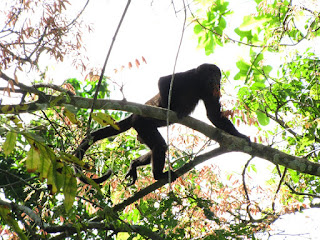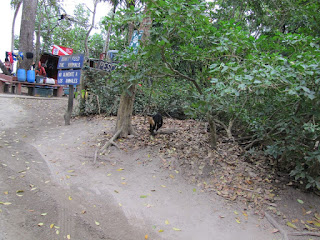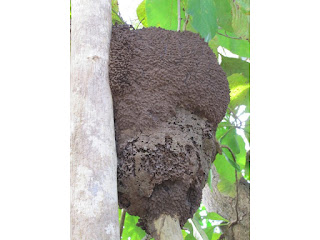
CURU is a very popular tourist destination in Costa Rica and they have made great efforts towards cleaning up and maintaining their environments. First I will show you a monkey sanctuary. This was an area that had been farmed but through time the younger generation moved to the city for work and there was only one final family member who remained. They offered up the land as a monkey sanctuary. This is one of the original homes they lived in.


A couple things to note about the rain forest here and rain forests in general. Because of the heavy amounts of precipitation the soils are often low in nutrients which leach out, the rains literally wash nutrients away. Sometimes it's only the thick covering of leaves that plants can use for nutrients and as you can see the root systems often hold the landscapes together. That is one of the reasons deforestation can lead to soil loss and even landslides.


As you can see, the quality of things like signage is mixed. Many of these areas that are now grassy were full rain forests before the large scale deforestation during and after colonialism. This one like others was switched to agricultural for a time but the soils were not able to sustain agriculture in a long term due to poor soils. Many of the tropical areas of the world are now more like a grassland after they tried farming for a while. Would the forest come back if they were not used as grazing land?




This was the dry season so you can see the water level of the stream is very low which allows you to again see how intricate the tree root system is in keeping the land from washing out. A dry season here can mean months of zero rain. You can also see some of the old growth larger trees here and there as we walk towards the preserve.


Above, she is pointing to what is sometimes called a "sensitive plant" that closes when you touch it. As I mentioned, this is a monkey sanctuary area and any injured monkey from outside the sanctuary can be brought in to this sanctuary to save it. It is put in this fenced area as it heals before it can be introduced to the larger population.

You can see the monkey recovering. There is also a goat and the purpose of the goat is to keep the grass short in the enclosure but since the monkey feeds the goat it's bananas (you can see it doing that in the above pics) the goat does not keep the grass low outside of the path from the monkey to the door in the fence.




As we walk further out into the forest we see more wildlife. You can see a termite mound here, they are edible and taste a bit like mint. A fair source of protein in a pinch, which is also how you capture them. You put your finger on their mound and they will swarm it and then you just gulp it down off of your finger. Of course, you could also go after something like the deer you see in this above photo if that is more to your protein tastes. Now we will get to the primary tourist gathering place for our tour.




You can see several students here filling out some evaluations as this establishment is under review for ecotourism funding from the national government. You can also see some of the recycling that has become common in the area. Many other tourist places around the world will have giant piles of garbage which obviously is not a sustainable form of tourism for any ecosystem. They have made great strides towards recycling and keeping natural areas clean over the 20 years I have been traveling here.




Not sure if you can make it out, but you might see bananas placed on the fence to the door of his structure above. This is where the elderly woman lives whose family owned this land before she decided to turn it over into a monkey sanctuary. Nobody else is allowed to feed the monkeys as you can see from the signs, except for her. That was a condition of the deal she made with the government to hand the land over to them. Monkeys are of course quite common all over Costa Rica, you can see them going around in packs and eating from various trees as they go kind of as common as squirrels are in Minnesota but of course there are also tropical squirrels there. You can see one in a photo below trying to avoid the spikes you see on many tropical trees.









I would say this is a pretty good example of ecotourism success. As you can see form the pictures, they have all of the normal things that you might expect on a tour. It is also local run unlike many other tourist traps where the resort owners make all of the money and supplies are shipped in so locals don't supply much and thus don't make much money. They have plenty of picture opportunities, scuba and snorkel, there is a nearby beach and wildlife to see. This is not as famous as Tortuguera or Monte Verde and it's preserve is not as large but I will post those in a separate post.
I will make a couple more posts on Costa Rica including more wildlife and eco and regular tourism so stay tuned.




No comments:
Post a Comment